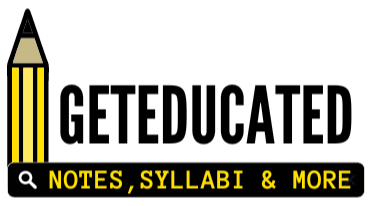Hello readers, eager to know the Latest BBA Hons. 2nd Sem Syllabus for Calcutta University and it’s affiliated colleges ? Fine! this post will cover your syllabus along with Marks Distribution as prescribed by CU (Calcutta University).

Statistics for Business Decisions (BBAA202C3)
Credits – 6, Marks – 100
Unit 1 :
Definition of Statistics; Importance and scope of Mathematics and Statistics in business
decisions; Limitations. Primary and Secondary data; Methods of data collection;
Tabulation of data; Graphs and charts; Frequency distributions; Diagrammatic
presentation of frequency distributions.
Unit 2 :
Measures of Central Value: Characteristics of an ideal measure; Measures of Central Tendency – mean, median, mode, harmonic mean and geometric mean. Merits, Limitations and Suitability of averages. Relationship between averages. Measures of Dispersion: Meaning and Significance. Absolute and Relative measures of dispersion – Range, Quartile Deviation, Mean Deviation, Standard Deviation, Coefficient of Variation, Moments, Skewness, Kurtosis.
Unit 3 :
Correlation Analysis: Meaning and significance. Correlation and Causation, Types of
correlation. Methods of studying simple correlation – Scatter diagram, Karl Pearson’s
coefficient of correlation, Spearman’s Rank correlation coefficient, Regression Analysis:
Meaning and significance, Regression vs. Correlation. Linear Regression, Regression
lines (X on Y, Y on X) and Standard error of estimate.
Unit 4 :
Analysis of Time Series: Meaning and significance. Utility, Components of time series,
Models (Additive and Multiplicative), Measurement of trend: Method of least squares,
Parabolic trend and logarithmic trend; Index Numbers: Meaning and significance,
problems in construction of index numbers, methods of constructing index numbersweighted and unweighted, Test of adequacy of index numbers, chain index numbers, base shifting, splicing and deflating index number.
Unit 5 :
Probability: Meaning and need. Theorems of addition and multiplication. Conditional probability. Bayes’ theorem, Random Variable- discrete and continuous.
Probability Distribution: Meaning, characteristics (Expectation and variance) of Binomial, Poisson, and Normal distribution. Central limit theorem.
Course Objective:
To familiarize the students with various Statistical Data Analysis tools that
can be used for effective decision making. Emphasis will be on the application of the
concepts learnt.
Readings:
- S.P. Gupta (S.P.): Statistical Methods, Sultan Chand & Sons, 34th Edition.
- Richard Levin & David Rubin : Statistics for management, Prentice Hall.
- Anderson, Sweeny & Williams: Statistics for Business and Economics, South Western
Managerial Economics (BBAA203C4)
Credits – 6, Marks – 100
Unit 1 :
Demand, Supply and Market equilibrium: individual demand, market demand,
individual supply, market supply, market equilibrium; Elasticities of demand and supply :
Price elasticity of demand, income elasticity of demand, cross price elasticity of demand,
elasticity of supply; Application of elasticity concepts in marketing/sales decision making.
Concepts of demand elasticities and relationship into total revenue in pricing decisions.
Theory of consumer behavior : cardinal utility theory, ordinal utility theory(indifference curves, budget line, consumer choice, price effect, substitution effect, income effect for normal, inferior and giffen goods), revealed preference theory.
Unit 2 :
Producer and optimal production choice : optimizing behavior in short run(geometry of product curves, law of diminishing margin productivity, three stages of production), optimizing behavior in long run (isoquants, isocost line, optimal combination of
resources). Applications of the concept of cost elasticities to determine plant size. Concept of
Minimum Efficient Scale in transportation industry.* Costs and scale : traditional theory of cost ( short run and long run, geometry of cot curves, envelope curves), modern theory ofcost (short run and long run), economies of scale, economies of scope.
Unit 3 :
Theory of firm and market organization : perfect competition (basic features,
short run equilibrium of firm/industry, long run equilibrium of firm/industry, effect of
changes in demand, cost and imposition of taxes) ; monopoly (basic features, short run
equilibrium, long run equilibrium, effect of changes in demand, cost and imposition of
taxes, comparison with perfect competition, welfare cost of monopoly), price discrimination,
multiplant monopoly ; monopolistic competition (basic features, demand and cost, short run equilibrium, long run equilibrium, excess capacity). Role of advertisement in monopolistic competition, oligopoly (Cournot’s model, kinked demand curve model, dominant price leadership model, prisoner’s dilemma).
Unit 4 :
Factor market: demand for a factor by a firm under marginal productivity theory ( perfect
competition in the product market, monopoly in the product market), market demand for a
factor, supply of labour, market supply of labour, factor market equilibrium.
Objective:
The purpose of this course is to apply micro economic concepts and techniques in evaluating
business decisions taken by firms. The emphasis is on explaining how tools of standard price
theory can be employed to formulate a decision problem, evaluate alternative courses of action and finally choose among alternatives. Simple geometry and basic concepts of mathematics will be used in the course of teaching.
Readings:
1.Dominick Salvatore (2009). Principles of Microeconomics (5thed.) Oxford University Press
2.Lipsey and Chrystal. (2008). Economics. ( 11thed.) Oxford University Press
3.Koutosyannis (1979). Modern Micro Economics. Palgrave Macmillan
4.Pindyck, Rubinfeld and Mehta. (2009). Micro Economics. (7thed. ). Pearson.
*5. Mark Hershey, Managerial Economics
Business Ethics (BBAA204GE2)
Credits – 6, Marks – 100
Unit 1:
Business ethics: Meaning of ethics, why ethical problems occur in business. Ethical
principles in business: Teleological and Deontological Theories of ethical reasoning ; ethics of
care, Integrating utility, rights, justice and caring; Virtue ethics, Ethical issues in business:
Worker’s and employee’s rights and responsibilities, Profit maximization vs. social
responsibility.
Unit 2 :
Corporate social responsibility: Concept; stakeholder theory and corporate social responsibility; types of corporate responsibility; multinational business and corporate citizenship; Corporate social responsibility under Companies Act 2013
Unit 3 :
Corporate governance: concept, Need to improve corporate governance standards,
Features of good governance, Role played by regulators to improve corporate
governance, accounting standards and corporate governance, corporate disclosure, insider
trading; The Board –Quality, Composition and role of Board, Outside Directors on the board
(independent, nominee), Executive and Non-Executive directors, SEBI clause 49,
directors and financial institutions in enhancing corporate governance, critical issues in
governance of board directors, CEO Duality.
Unit 4 :
Role of auditors in enhancing corporate governance, duties and responsibilities of
auditors, corporate governance and internal auditors, Whistle blowing: Kinds of whistle
blowing, precluding the need for whistle blowing. Discrimination, affirmative action, and
reverse discrimination: Equal employment opportunity, Affirmative action, Preferential
hiring, Corporate social responsibility: Meaning, Evolution of corporate social
responsibility, common indicators for measuring business social performance, reporting
social responsibility measures in annual report.
Objective:
The objective of this paper is to make the students more clear about the importance of ethics in business and practices of good corporate governance. It also talks about the corporate social responsibility.
Readings:
1.Manuel G Velasquez : Business ethics- concepts and cases Pearson.
2.Luthans Hodgetts and Thompson: Social issues in business, Macmillan USA
3.A.C. Fernando: Business Ethics Pearson Education.
4.A.C. Fernando: Corporate Governance Pearson Education.
5.Adrian Davies: Strategic approach tocorporate governance Gower Pub Co.
6.N. Gopalswamy: Corporate governance a new paradigm A H Wheeler Publishing
Co Ltd.
7.Marianne M Jennings: Cases in Business Ethics Indian South-Western College
Publishing
8.Kevin Gibson: Ethics and Business, An Introduction, Cambridge Applied Ethics
Cambridge University Press
9.Bhanumurthy K V: Ethics and Social Responsibility of Business, Pearson Education India.
Business Communication (BBAA201AE2)
Credits – 2, Marks – 100
Unit 1: Introduction
Objectives, importance, elements, process, forms, models, principles of effective
communication, barriers to communication and remedial measures, role of communication in conflict resolution Formal and informal communication, Grapevine, Characteristics of corporate communication, Characteristics of corporate communication, Communication network.
Unit 2: Types of Communication
English Language and communication: Parts of Speech Person, Gender, Number ,Use of Tense, Prepositions and Adverbs of Time and Place, Degree, Adjectives Forming questions, Negation and Relative Clauses Interchange of Sentences, Narration, Voice change, Proverbs, Vocabulary, Proper use of words, Idioms.
Unit 3: Tools of Communication
Emergence of communication technology, Modern Forms of communication, Fax, Email, Video Conferencing, English for Special and Technical Purpose Official letter, Paragraph writing, Notemaking, Topic Sentence. Telephonic Conversation, Group Discussion regarding job interview.
Unit 4: Drafting
Business Meetings, Meeting Etiquettes, Notice, Circular, Resolution and minutes , Business letter writing- Offer letter, Quotation, Status enquiry, Confirmation, Execution, Refusal and
cancellation of order, Recommendation, Credit collection, Claim, Bank loan . C. V. Writing.
Scientific and technical subjects, Formal and informal writings Reports, handbooks, manuals,
letters, memorandum.
Suggested Readings :
•Anjanee, S. & Bhavana Adhikari, Business Communication, TMH
- Chaturvedi &Chaturvedi, Business Communication : Concepts, Cases andApplications, Pearson
- M.K.Shegal&Vandana Khetarpal, Business Communication, Excel Books
- R.K.Madhukar, Business Communication, Vikash Publishing House Pvt. Ltd.
- Rao, Kumar & Bindu, Business Communication, Cengage
- Khanna, Puja., Business Communication, Vikash
- Raman & Sharma, Technical Communication, Oxford
- Lesikar, Flatley et al, Business Communication, McGraw Hill
